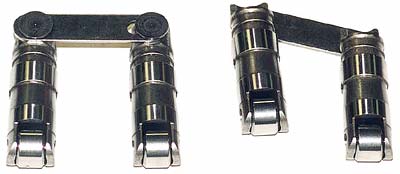|
CAM-ROD-ERY
Picking The
Right Low
Buck Cam Combination
PART 1
Words and Photos
by Wayne Scraba
2/11/04

What camshaft is right for your car? As you
might have expected, there's some good news
and there's also some bad news. Let's look at
the bad stuff first. Given the overwhelming
number of different engine combinations, vehicle
setups, usage's and of course, camshaft grinds
available, it is virtually impossible to make
specific cam recommendations for each and every
car, at least within the confines of this article
(a book maybe). On the other hand, there's good
news too. We've compiled some basic guidelines
and generalities that can prove to be immensely
helpful in the camshaft selection department.
Before we begin, think about this observation:
In a basic high performance car, do you really
need a flat tappet roller camshaft? Certainly
it's tempting to emulate the Pros, but the overall
costs associated with a high rpm, flat tappet
roller camshaft valve train coupled with the
maintenance program necessary to run such an
arrangement might not be in equilibrium with
grass roots motorsports. That isn't necessarily
bad either. There are plenty of very stout hydraulic
roller cams and solid lifter cams along with
good old-fashioned hydraulic cams out there
(and associated ancillary components). In fact,
you might be pleasantly surprised at how much
power a mild cam can produce. One more consideration
is this: Take a look at the performances turned
in by today's NHRA Stock Eliminator cars. Some
combinations use hydraulic rollers (late model
Camaros and Firebirds are a good example), and
plenty more of those drag race stockers use
a flat tappet of some sort (hydraulic or solid).
And plenty of them run elapsed times deep into
the ten-second zone. Granted, some Stock Eliminator
racers use trick lifters that act more or less
like solids, but many don't. Just as important,
those cars are valve lift limited (which makes
for some rather unusual grinds). Bracket cars
and dual duty street-strip cars aren't.
 This
is a view of Crane's new hydraulic roller lifters.
The benefits include reduced operating friction
plus the increased torque and horsepower of
a roller cam. A properly engineered hydraulic
roller tappet grind produces a broad power band
and increased RPM potential with the low-maintenance
of a hydraulic cam. Precision check ball internal
valving prevents "pump up". Meanwhile, the bodies
are CNC machined and assembled with a special
"anti-rotational guide bar" design where applicable. This
is a view of Crane's new hydraulic roller lifters.
The benefits include reduced operating friction
plus the increased torque and horsepower of
a roller cam. A properly engineered hydraulic
roller tappet grind produces a broad power band
and increased RPM potential with the low-maintenance
of a hydraulic cam. Precision check ball internal
valving prevents "pump up". Meanwhile, the bodies
are CNC machined and assembled with a special
"anti-rotational guide bar" design where applicable.
Pressure Tactics ...
Even if you choose to go with a less exotic
hydraulic cam, you still have to deal with the
selection process. After deciding upon the camshaft
type, the next item that you should consider
in any engine package is cylinder pressure.
While you may have never given this any thought,
the camshaft is an integral component in the
combustion process. In the heyday of the Detroit-built
muscle car, compression ratios ranged between
10.5:1 and 12.5:1. A typical racecar can feature
compression ratios in excess of 14:1 while many
professional class drag cars (normally aspirated)
feature static compression ratios in the area
of 16:1. Generally speaking, a lower compression
ratio street-style engine can easily use a camshaft
that produces more cylinder pressure without
fear of detonation. If this very same camshaft
is installed in a powerplant with a high static
compression ratio, the chances of experiencing
severe detonation are increased manifold. In
contrast, if a camshaft that is designed for
use in a high static compression ratio engine
is installed in a low C.R. "emission" or super
low octane pump gas motor, the engine will simply
roll over and die. Throttle response will be
soggy and so will the power output.

|